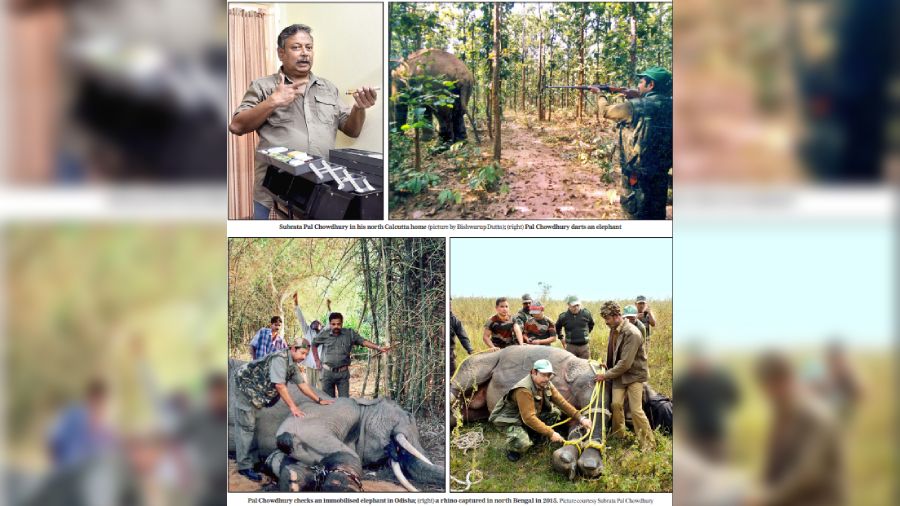One hundred and fourteen elephants, 14 rhinos, eight tigers and four leopards. Not to mention the count of smaller animals that runs into many hundreds.
The population of several forests put together is the career haul of one man.
Subrata Pal Chowdhury is not a hunter but has to think like one. He is, by far, India’s most prolific name in the “chemical immobilisation” of wild animals. In simple terms, Pal Chowdhury is known for having put countless animals to sleep, albeit temporarily, with dart guns loaded with tranquillising drugs.
He retired from the state forest department as a technical assistant (wildlife) in 2020.
The list ranges from rogue elephants to maneaters of the Sunderbans. The animals needed to be tranquilised for relocation to avoid conflict with humans or for tagging animals with radio collars.
Sunderbans, Jungle Mahal and forests of north Bengal, there is no forest in Bengal where Pal Chowdhury has not worked. He has also answered emergency requests from the forest departments of several other states in India.
He has escaped death by a whisker and endured several broken bones.
At the auditorium of a city school on Tuesday, an NGO hosted an awards programme in the run-up to the Global Tiger Day on July 29. The ceremony saw a host of serving and retired forest officials and guards being felicitated. But the loudest cheer was reserved for Pal Chowdhury.
A couple of days later, at his family home — overlooking the Hooghly — near Kashi Mitra burning ghat in north Kolkata, Pal Chowdhury shared some of his memorable encounters with The Telegraph.
Bones crunching
In February 2002, a rogue tusker killed 16 people — eight in Jharkhand before moving into Bengal and eight more in Mohammad Bazar block in Birbhum’s Suri.
Pal Chowdhury and his team located the elephant in a forest near Gonpur village. The elephant was “around 14 years, still a couple of years from reaching adulthood”.
The elephant was facing a large crowd of locals. Pal Chowdhury and his team crept up behind the animal. He fired and the dart hit the hip area of the elephant, prompting it to turn around.
From a distance of less than metres, the tusker was now staring at Pal Chowdhury. “It waited for a few seconds and then charged at us,” said Pal Chowdhury.
The drug does not work instantly and takes some time to put a large animal like an elephant to sleep.
A forest guard fired pellets from another gun at the jumbo but failed to deter it.
Elephants can run at over 30kmph. A tusker in full charge can scare the wits out of even seasoned foresters.
While running, Pal Chowdhury tumbled on a thicket and fell to the ground. The elephant ran past him before stopping and turning back.
“The elephant raised the right front leg to trample on my stomach. I was lying flat and tried to turn towards a tree. I felt the weight of the leg. I literally felt my bones crunching. But I did not move or make any sound. I just lay still. The elephant thought I died and marched ahead,” said Pal Chowdhury.
But soon after, the drug worked and the elephant fell asleep.
The tusker eventually left him with a smashed pelvis, ribs, right elbow and lower jaw. Pal Chowdhury was taken to a hospital and then to one in Kolkata, where he underwent seven surgeries and spent three months.
Tiger on tree
In December 1994, a tiger from the Sunderbans Tiger Reserve strayed into a village in Kultali.
Pal Chowdhury and other foresters were on its trail for three days. One day, they learned that the tiger was atop a date palm tree on Piyali Island.
“Initially, we thought it was a joke. But we decided to go. The place was an open field. As we anchored our boat and started walking, we could see a crowd of thousands. Upon reaching there, we actually saw the tiger on top of the tree,” said Pal Chowdhury.
Keeping the crowd off with the help of police, Pal Chowdhury walked near the tree. “The tiger was perhaps intimidated by the crowd and stayed put on the top of the tree. It took me a while to find a suitable shooting spot as the leaves marred visibility. Finally, I took aim and fired. The dart stuck just the area above the right hind leg of the tiger,” he said.
The tiger still showed no signs of coming down. It fell asleep on the tree itself.
Bringing the animal down was another challenge. A large nylon net was held out below the tree. A man then climbed the tree with a rope and tied the legs of the tiger with it. The rope was then pulled from below and the big cat landed on the net.
Think like a hunter
Pal Chowdhury thinks people like him should have hunter’s instincts. “In the forest, it is a constant game of one-upmanship between you and the animal,” he said.
“On-the-job training has been my biggest learning. I have made mistakes and learnt with every assignment,” he said.
Firing from a dart gun is just a part of his job, he said. “Using the right dosage of the drug is very crucial. Similarly, the logistics before and after tranquilising an animal is also of equal importance,”he said.
Ravi Kant Sinha, former chief wildlife warden ofthe state, has known Pal Chowdhury for close to three decades.
“He evolved to emerge as aglobal expert on tranquillisation. I sent him to many statesand always received excellentfeedback. He was an asset. It istough to replace him,” he said.
